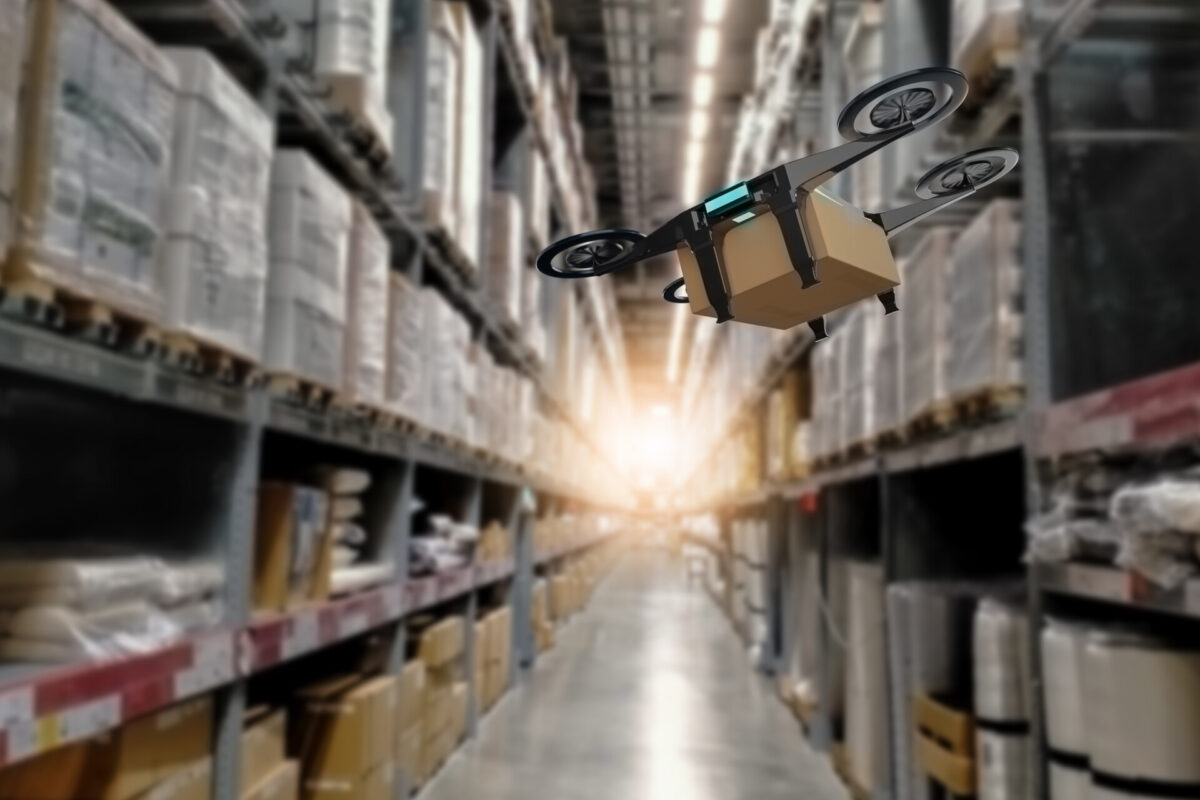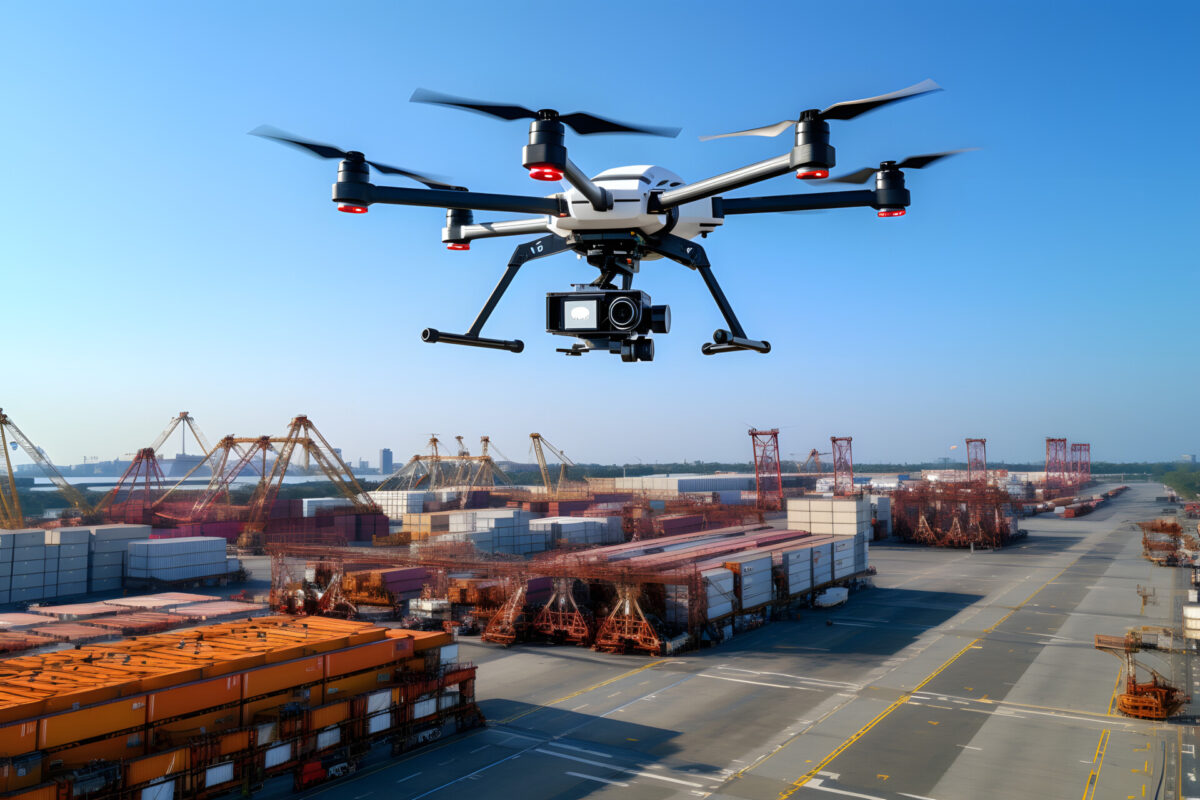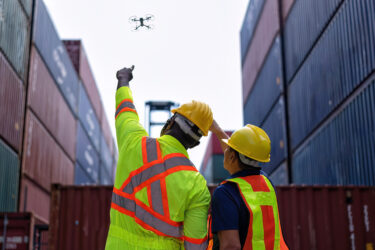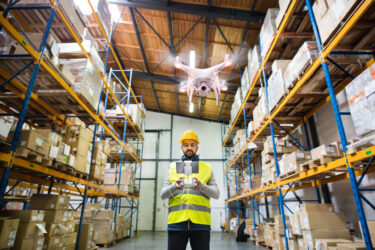

Integrating drones in manufacturing adds a new standard of automation and efficiency. Technological progress has made them much more than just fancy flying cameras. With advancements in AI, computer vision and machine learning that can boost drones will be a game-changer in modern factories and manufacturing facilities. In this article, we’ll go through ten essential applications of drones in this industry. However, let’s start with the basics of advanced AI-driven.
- What are AI Drones?
- Technological Advancements for Drones in the Manufacturing Industry
- Artificial Intelligence Solutions for Manufacturing and Warehousing
- Transforming Warehousing and Manufacturing with Computer Vision
- Transforming Warehousing and Manufacturing with Machine Learning Development for the Manufacturing and Warehousing Sector Vision
- Technological Complementations – LiDAR, SLAM and Stereovision
- An Outline of the Current State of AI-Driven Drones in Manufacturing
- What Are the Most Prominent Applications of Drone Technology in the Manufacturing Industry?
What are AI Drones?
AI drones are unmanned aerial vehicles (UAVs) equipped with artificial intelligence technology, enabling them to perform tasks autonomously or with minimal human intervention. They can analyse data from their sensors in real-time, make decisions, navigate complex environments, recognise objects, and adapt to changing conditions. Applications of AI-driven drones spread across various industries and include surveillance, inspection, mapping, delivery, and monitoring. AI enables drones to undertake complex missions, improve operational efficiency, and offer new possibilities in commercial and research domains.
Technological Advancements for Drones in the Manufacturing Industry
Smart manufacturing drones use various advanced technologies that increase their technical capabilities. Here are the most critical technologies that drive the industrial applications of drones.

Artificial Intelligence Solutions for Manufacturing and Warehousing
AI plays a critical role in drone use for manufacturing development. AI-driven drones autonomously capture, process and analyse aerial data. The technology can convert images into accurate maps, 3D meshes, or thermal images, providing a comprehensive view of the surveyed area. Leveraging AI in drones also transforms captured raw data into actionable insights for safety And enhancements. AI is the fundamental technology for creating advanced drones. Another essential technology in innovative drone development for manufacturing is machine learning.
Transforming Warehousing and Manufacturing with Computer Vision
Computer Vision is undoubtedly one of the most critical advanced technologies in drone technology enhancements. It enables autonomous flight, navigation, safety, and various industrial applications. Moreover, drones can perform multiple tasks, including inspection and quality control, inventory management, 3D mapping and modelling, and inventory management. Well-implemented computer vision technology and machine-learning models offer unparalleled efficiency, safety, and data analysis capabilities.
Transforming Warehousing and Manufacturing with Machine Learning Development for the Manufacturing and Warehousing Sector Vision
Leveraging deep-learning neural networks enables drones to sift through objects (for example, people in a crowd or trees in the forest) to identify those of interest, inspect sizable industrial equipment, and generate real-time damage reports. Machine Learning also boosts data analysis by detecting patterns, anomalies, or specific conditions. Drones can benefit inventory management by using machine-learning algorithms to identify inventory items. This technology also encourages a predictive maintenance approach that helps prevent costly downtime and extends the lifespan of manufacturing equipment.
Technological Complementations – LiDAR, SLAM and Stereovision
The abovementioned technological advancements benefit from adding other technologies to leverage their capabilities. It’s important to mention the three that can be extremely useful in drones – LiDAR, SLAM and Stereovision.
LiDAR – Light Detection and Ranging
This technology provides accurate depth information essential for understanding the three-dimensional structure of the environment. LiDAR sensors emit laser beams to measure distances to objects, creating high-resolution 3D maps of physical surroundings. This data can be used with computer vision techniques to enhance autonomous systems’ perception and interaction capabilities, such as drones. It allows drones to map the facilities for more effective route planning, defining the more dangerous areas or those requiring more surveillance and quality control.
SLAM – Simultaneous Localisation and Mapping
It uses visual data to solve two essential problems: mapping the environment without prior knowledge and determining the agent’s position on the map as it navigates. This process involves complex algorithms that interpret data from various sensors, such as cameras, LiDAR, or inertial measurement units, to create a consistent and accurate map in real-time and to estimate the agent’s position and orientation within the map. SLAM is crucial for autonomous navigation and exploration applications. It can also help in quality control by ensuring that the moving elements operate as they should or workers are in their assigned positions when necessary.

Stereovision
Stereovision technology utilises two or more cameras to mimic human binocular vision. This arrangement allows drones to perceive depth in their environment, a crucial capability for obstacle avoidance, navigation, and mapping in three-dimensional space. It provides valuable data for various applications, such as 3D mapping, autonomous flight, and object detection and tracking. It is beneficial in environments where other navigational aids, like GPS, might be unreliable or unavailable. Stereovision enhances drones’ ability to understand and interact with their surroundings autonomously. It can be especially beneficial for tasks like supporting quality inspection, surveillance and deliveries around the warehouse.
Our experts have experience in LiDAR, SLAM and stereovision solutions, including every stage of creating it, algorithms, camera calibration, and implementation, so they can help you add AI-based enhancements to your drone operations in manufacturing, warehousing and other sectors where drone solutions apply.
An Outline of the Current State of AI-Driven Drones in Manufacturing
AI-powered drones are already finding their use in the manufacturing industry. In the past two years (2022-2023), we could highlight the following successful use cases of drones in this industry and more:
What Are the Current Challenges of Implementing Drones for Manufacturing?
Like every technological advancement, using drones in manufacturing comes with various challenges. Overcoming them might be difficult. However, with skilled experts like ours, it might be more accessible. Let’s review several difficulties involved in commercial operation.
Technology Infrastructure and Interoperability
Manufacturing sites often use a diverse range of machines and production systems, leading to issues with interoperability and the integration of new technologies. That’s why it’s essential to establish a standardised ecosystem for seamless connectivity between various systems beforehand.
Data Quality
For the successful implementation of AI drones, high-quality, clean and meaningful data is vital. Since industrial settings can produce biased, outdated, or error-filled data, complicating AI deployments, ensuring that the data we use to train the AI models is verified for quality is critical.
Trust and Transparency
AI is a complex technology with a seemingly abstract nature that can sometimes raise doubts and lead to mistrust. However, with AI experts like ours, these technologies will become more transparent, and we’ll show you that they can be trusted when implemented carefully and with attention to detail.
Regulatory Challenges
The deployment of drones in manufacturing settings is gaining momentum, so adhering to local and federal regulations is becoming a pivotal concern for drone manufacturers. Responsible operations must comply with safety, security, and privacy regulations. It might be challenging, as legal issues are consistent and precise regulation can be complicated.

What Are the Most Prominent Applications of Drone Technology in the Manufacturing Industry?
There are many industrial applications of drones. Let’s cover those that are the most prominent:
- Inventory management and efficiency
- Quality control and safety compliance inspection
- Surveillance and maintenance
- Environmental monitoring
- Route planning and delivery logistics
- Supply chain management
- Health and safety compliance inspections
- Energy efficiency enhancements
- 3D mapping and modeling
- Real-time data collection
Let’s get into more detail about each of the above.
1. AI-driven Drones for Warehouse Inventory Management and Efficiency
One of the most prominent applications of drones in manufacturing is inventory and production line management. There are several tasks that drones can automate in warehouses and production lines, including the following:

2. Assembly & Production Line Quality Control and Safety Compliance Inspection with AI and Drones
Another example of commercial drone operation applications is helping in quality control and safety, asset and compliance monitoring and inspections. Computer Vision-enhanced drones can monitor the inventory and equipment for failures, thus ensuring that human workers can avoid potentially dangerous situations. Moreover, they can be used for critical infrastructure inspection and detect malfunctions and leaks (e.g. gas) early to help prevent the spread and potentially put the employees and operations at risk.
Using drones can relieve human stuff from potentially dangerous jobs like retrieving products from tall racking, troubleshooting dangerous equipment during work stoppages, responding to spills and navigating mezzanines.
3. AI Drones for Surveillance and Maintenance of Manufacturing Facilities and ProcessesDrones
Smart manufacturing can utilise advanced drones to efficiently monitor large manufacturing facilities and infrastructure, capturing high-quality images and videos for real-time analysis. It helps to swiftly detect potential issues, including any equipment failure, malfunctions or safety hazards, thus helping to prevent accidents and ensure a safe working environment.
A notable advantage of using drones in industrial settings is their ability to access hard-to-reach or dangerous areas. It includes tall structures, hazardous environments, and confined spaces where manual inspections would pose significant risks to safety. Drones can perform these inspections in real-time without disrupting operations, enhancing safety and productivity.
Drones enable remote inspection capabilities, where live video streaming from the drone’s camera allows off-site experts to analyse data and advise on necessary repairs or adjustments. This reduces the need for physical presence in potentially hazardous areas and leverages expertise from across the globe to address maintenance issues promptly and effectively.
4. Environmental Monitoring for Early Warning with AI-Driven Drones
Drones enable data gathering without human intrusion into sensitive or dangerous environments, minimising the risk of disrupting ecosystems or endangering wildlife and human lives. They allow for the study of challenging terrains and disaster zones safely and effectively.
Automated guided vehicles can be ideal for investigating accidents and disaster areas without compromising staff safety. Drones enable data gathering without human intrusion into sensitive or dangerous environments, minimising the risk of human injuries. They allow for the study of the site more effectively and safely.
Healthcare is another important department where computer vision systems can find their place. The ability of the neural network AI systems and machine learning to detect objects may prove helpful in analyzing and interpreting medical images to aid with cancer detection and other diagnostic tasks by human doctors. It can contribute to speeding up the diagnosis and starting the necessary treatment.
5. Enhanced Route Planning and Delivery Logistics with Drones
Drones offer a promising alternative to traditional delivery methods, potentially alleviating traffic congestion, reducing delivery times, and minimising environmental impact using electricity instead of fossil fuels. However, some work still needs to be done to detect paths and avoid collisions correctly. Additionally, the attempts at delivery drones show that they still need some enhancements to carry heavier loads safely to their destination. There’s no denying, though, that the potential and benefits of these applications are worth considering. Drones can be used to deliver tools and other items around the facility, saving manual work.

6. Drone-Enhanced Supply Chain Management
Drones significantly impact supply chain management by enhancing efficiency, safety, and speed in various segments like inventory management, surveillance, and delivery. In warehouse operations, drones are revolutionising inventory management processes. For instance, pilot studies, such as those conducted by DSV using self-flying inventory drones, have shown that drones can save up to 50% of data collection time, potentially increasing to 80% efficiency once fully operational. This leap in efficiency is attributed to drones’ ability to quickly and safely scan inventory, even in extensive facilities. Integrating drones into supply chain management is still evolving, with ongoing developments addressing regulatory compliance, security concerns, and technical limitations such as battery life. It can be especially useful in facilities that are rapidly scaling or want to rely less on manual work.
7. AI Drones for Health and Safety Compliance Inspections
Another example of using UAVs for commercial and industrial applications is inspecting health and safety compliance on-site. They can provide invaluable support for human work and offer a safer alternative to traditional methods by allowing inspections in hard-to-reach or dangerous locations without putting inspectors at risk. For example, drones can be utilised for visual inspections and data gathering on significant assets, significantly protecting inspectors from hazardous conditions and enabling remote monitoring through the drone’s camera. They can also be used to survey the employees to ensure they adhere to the safety code or wear PPE when necessary.
8. Machinery Energy Efficiency Enhancements with Drones AI
Drones equipped with infrared and thermal technology can identify inefficiencies in machinery or electrical systems by detecting areas of heat loss or overheating components. This capability allows targeted maintenance to prevent energy wastage, ensuring that equipment operates optimally and conserves energy.
Regular use of drones for asset monitoring and maintenance in manufacturing environments can lead to substantial energy savings. By ensuring that equipment is functioning correctly and efficiently, drones help reduce unnecessary energy consumption, contributing to a more sustainable operation.
UAVs can also be used to communicate with IoT devices to provide a comprehensive view of energy usage within a facility. IoT sensors deployed throughout a manufacturing plant can track energy consumption in real-time. This data, combined with insights gathered by drones, enables a detailed analysis of energy usage patterns and identifies areas where energy efficiency can be improved.
9. Using AI-Driven Drones for 3D Mapping and Modelling
High-resolution aerial imagery and 3D models generated by drones offer a comprehensive view of properties, enhancing real estate marketing and property inspections. They can quickly cover large areas, producing accurate 3D models and maps. They can be an invaluable aid in facility planning and maintenance. Since some equipment is more prone to failure than others, manual inspection could be challenging, similarly in the areas that can be dangerous for workers.
Maps and models generated by drones can show different areas within the facility, providing enhanced asset monitoring and pointing out areas that may be more prone to failures or create a potential danger to workers. They can also help plan maintenance and inspections around the facility or indicate areas for upgrades and enhancements.
10. Real-Time Data Collection and Processing with Smart Drones
One of the critical advantages of drones is their ability to gather vast amounts of data much faster than ground-based methods, significantly reducing the risk associated with data collection operations by minimising human exposure to potentially hazardous environments.
Moreover, different solutions allow different methods to store and process the data drones collect. Our experts note that data can be stored and processed within a drone without compromising energy efficiency. They can help you optimise the network and data consumption so that it has a low impact on the overall performance.
Here are several examples of how this real-time data collection can benefit manufacturing and warehousing operations:
Drones in Manufacturing: An Outlook for the Future
Although there are still some limitations to commercial drone operation, including high initial costs or consistent and transparent regulations, the future of drones in manufacturing looks promising. One of the key areas where drones have impacted factories is inventory management and quality control. Regulation and policy will play a crucial role in shaping the future of drone use in manufacturing. Adopting new regulations for autonomous drones to fly over people and the latest EU regulation on drone operation indicates a move towards harmonising drone operations across different risk categories. These regulations are essential for ensuring safety, security, and responsible drone usage in manufacturing environments.
Emerging trends, such as using LiDAR technology to create 3D maps and integrate artificial intelligence for anomaly detection, highlight the ongoing innovation in drone capabilities. These advancements are expected to improve further the efficiency, accuracy, and cost-effectiveness of drone applications in the manufacturing industry.
How Can We Enhance Your Manufacturing with AI and Drones?
With our expertise across technologies and deep knowledge of the most recent advancements, we can help you enhance your industrial operations with drones. Here are some examples of what we can help you achieve:
Don’t hesitate to contact us if you already have a specific goal or would like to brainstorm ideas to find the perfect solution. Our experts will schedule a discovery workshop with you, explain the technologies and propose the solutions that can take your company to the next level of innovation.
Katarzyna Świątek
Content Specialist at DAC.digital





